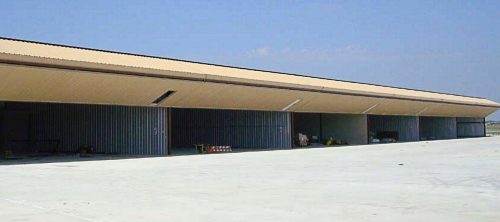
The Kansas City Aviation Department faced quite a conundrum a few years ago – what to do about its general aviation facility, Charles B. Wheeler Downtown Airport.
|
Facts & Figures Project: Hangar Construction Location: Charles B. Wheeler Airport, Kansas City, MO Cost: $18 million Architect: Wellner Architects General Contractor: Ideker Site Prep: Ideker Construction: Darland Construction Hangar Construction: Erect-A-Tube Aircraft Arresting Material: Engineered Arresting Systems Strategy: Raze old hangars and build on existing space due to small footprint and river bordering airport on three sides. Result: Increased hangar space; improved tenant retention Other Project Elements: 2 new taxiways, self-fueling equipment, new ramps, extension of utility service to northwest quadrant of airport and aircraft arresting system |
“We took a hard look at what we had in inventory and what we needed to do to upgrade and improve the mix of facilities,” recalls airport manager Michael Roper. “The existing 40 hangars were more than a half-century old. By razing them and removing a number of tie-down spaces, we were able to construct more modern facilities.”
With its recent $18 million project complete, the airport now boasts 96 new hangars in the same spot.
Meeting Demand
Choosing to expand the facility was an easy decision for Roper. When he and his staff evaluated the local availability of hangar space, they discovered every airport in a seven-county radius had a one- to five-year waiting list of aircraft owners looking for storage facilities.
“Because of our location (minutes from downtown Kansas City), we were confident that we could fill the space quickly and better serve the needs of businesses and professionals throughout our area,” explains Roper, noting that 85% of the airport’s traffic is business aircraft.
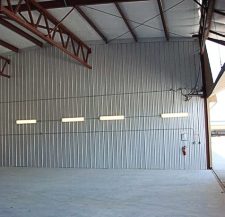 With the last of six new hangar buildings completed in November, 75 of the airport’s new 96 spaces were reserved by December. And staff was sifting through another 43 applications to fill the remaining spots.
With the last of six new hangar buildings completed in November, 75 of the airport’s new 96 spaces were reserved by December. And staff was sifting through another 43 applications to fill the remaining spots.
The airport now offers three types of hangars:
- Standard sizes (large enough for a Beech Baron) rent for $315.58 per month
- Large sizes (which accommodate a Beech Duke twin-engine jet) rent for $407.20 per month
Box hangars (for aircraft as large as Citation Jets) rent for $1,425.20 per month
Based on initial demand, Roper wishes he had more box hangars, because they have proved to be immensely popular. Even with most hangars rented and its waiting list growing, the airport staff still receives applications from walk-in clients every other week.
 Thanks to the desirability of the new buildings, the airport hasn’t lost a single tenant since its first revamped hangar opened. Roper takes that as a definitive sign that the new hangars are meeting the needs of aircraft owners. “One hundred percent of the comments we have received have been supportive, from people who appreciate our commitment to general aviation,” he reports.
Thanks to the desirability of the new buildings, the airport hasn’t lost a single tenant since its first revamped hangar opened. Roper takes that as a definitive sign that the new hangars are meeting the needs of aircraft owners. “One hundred percent of the comments we have received have been supportive, from people who appreciate our commitment to general aviation,” he reports.
Two new taxiways were built to support the new hangar space, and flight preparation areas were enhanced with self-fueling equipment and new ramps. Utilities were also extended to the entire northwest quadrant of the airport.
Except for a $1.5 million state grant for the new taxiways, the entire $18 million project was financed through airport fees.
 Assembled On Site
Assembled On Site
Wheeler Airport worked with several companies to construct its new hangar (see Facts & Figures on Page 40). Although construction started in 2007, the planning process began five years ago. Extra time was needed to ensure the project didn’t pose any environmental concerns to the nearby Missouri River.
The pre-engineered hangars were built offsite to meet building codes, and then delivered to the airport, where they were erected on poured foundations. The process ensured that the buildings could be constructed and readied for occupancy in five to six weeks.
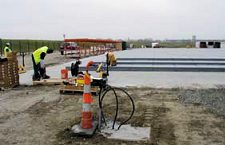 The airport’s box-style hangars are climate-controlled, with in-floor radiant heating. The other buildings are regular T-hangars. According to Jon Howell, director of sales for Erect-A-Tube, the hangars are made of structural steel tubing with exterior ribbed panels made of 26-gauge steel. Standard bi-fold doors provide hangar access.
The airport’s box-style hangars are climate-controlled, with in-floor radiant heating. The other buildings are regular T-hangars. According to Jon Howell, director of sales for Erect-A-Tube, the hangars are made of structural steel tubing with exterior ribbed panels made of 26-gauge steel. Standard bi-fold doors provide hangar access.
Because the airport is highly visible to people working and living in downtown skyscrapers, special attention was paid to the hangars’ exterior appearance, notes Matt Engle of Wellner Architects.
|
More Challenges The small size and river’s-edge location of Charles B. Wheeler Airport made the downtown Kansas City airport a prime candidate for an aircraft arresting system. Federal regulations require airports to have a 1,000-foot overrun area or approved barriers to help bring runaway aircraft safely to a stop. In some areas at Wheeler, runways come within a few hundred feet of the Missouri River, which borders the airport on three sides. So the airport purchased ground material from Engineered Arresting Systems to meet the requirements. “Both ends of Runway 1-9 at the Wheeler Airport lacked the required overrun space,” explains Kevin Quan, senior region director for Engineered Arresting Systems. The company’ s Engineered Material Arresting System (EMAS) is made of a lightweight, low-density concrete material that crumbles as an aircraft travels on it. The crushing action and the gravel created by it work in concert to bring fast-moving aircraft to a gentle halt with minimal damage to the aircraft. The first system was installed at the south end of Runway 1-9 and required about 300 feet in length at the end of the runway – nearly 70% less than the space required. “The material we use has been validated by the FAA and has a perfect record of saving lives and aircraft,” reports Quan. “The material used determines the level of deceleration based on the type of aircraft it can be expected to stop.” EMAS has successfully stopped every aircraft that has entered one of its beds, Quan says, including a 747 at John F. Kennedy Airport in January 2005. “Our product doesn’t rely on friction, so it works under all weather conditions,” he specifies. “As the aircraft’s tires pass over the system, they just sink into the material.” According to Quan, Wheeler was the first airport in FAA’s Central Region to install an EMAS bed. The solution, he says, was the best option available to the airport. The north end of Wheeler is expected to get an EMAS next spring. “It would have cost the airport much more to move the river, if they could have received permission at all,” says Quan. “EMAS offers lower cost, takes significantly less time to construct and has limited environmental impact on the surrounding area.” Smaller airports like Wheeler aren’t the only candidates for EMAS, notes Quan. Larger airports may consider the option as they seek ways to comply with a new federal law requiring overrun safety areas to be modified by 2015. Engineered Arresting Systems reports installing 48 EMAS beds worldwide through the end of 2009. |
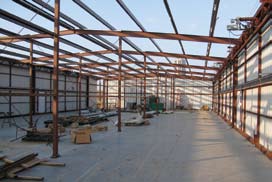 “The existing buildings were sort of a makeshift color scheme,” Engle explains. “We created a holistic approach to ensure the hangars didn’t stand out. With the tan steel walls, the buildings blend into the surrounding landscape, but we dressed them up with a brick veneer over the entry ports to give them a more professional appearance. We also installed a green roof that not only helps brings a little color to the airport, it helps control the interior temperature of the hangars themselves.”
“The existing buildings were sort of a makeshift color scheme,” Engle explains. “We created a holistic approach to ensure the hangars didn’t stand out. With the tan steel walls, the buildings blend into the surrounding landscape, but we dressed them up with a brick veneer over the entry ports to give them a more professional appearance. We also installed a green roof that not only helps brings a little color to the airport, it helps control the interior temperature of the hangars themselves.”
A Bright Future
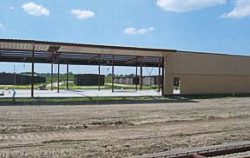 Roper believes the future of general aviation is strong and will continue to grow as more companies come to rely on private aircraft for business travel – especially in Kansas City.
Roper believes the future of general aviation is strong and will continue to grow as more companies come to rely on private aircraft for business travel – especially in Kansas City.
“Our airport is a stone’s throw from downtown Kansas City, which is the economic center of the entire region,” he explains. “People can fly into the airport and be walking into downtown offices in 10 minutes. Business owners in our area love the convenience and location.”
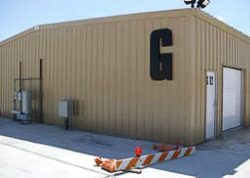
While Roper acknowledges general aviation “lost ground” in the last year, he thinks business aviation will grow. “There is so much demand for hangars and airport space now,” he notes. “I see space becoming even more difficult to find as the economy improves.”
According to Howell, aviation trends are showing definite increases in the use of private aircraft. “Private aviation will undoubtedly come back,” he says. “It is becoming the primary source of transportation for corporate executives and small business owners. People don’t really understand how vitally important air transportation is for moving information, people and products.”
Fortunately, aircraft owners based at Wheeler Airport do seem to understand.


